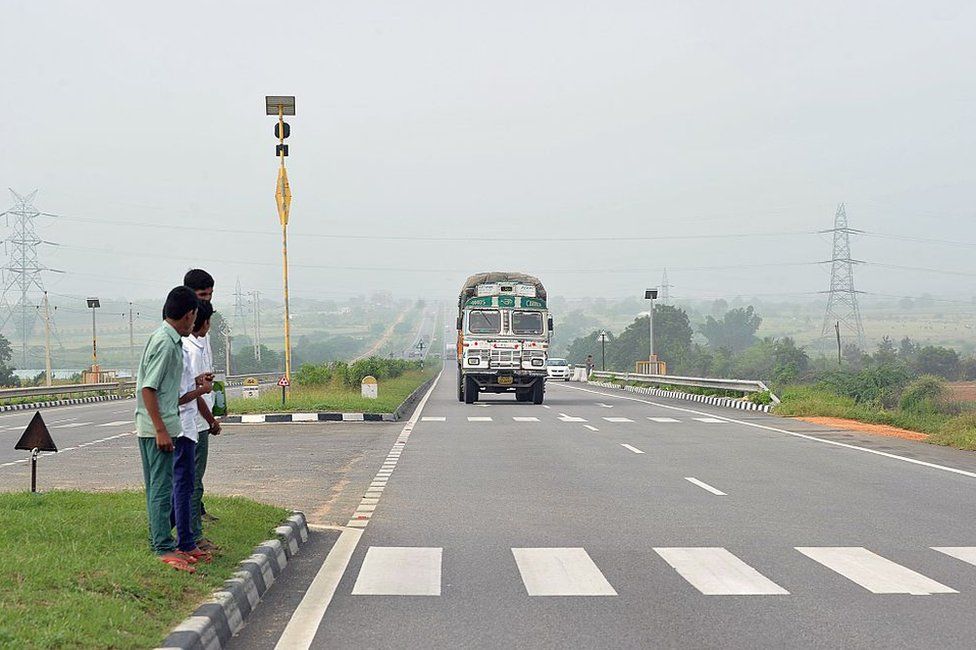India's $100bn road building gamble to boost economy
- Published

The Indian government is planning to kickstart economic growth by building a huge road network. The idea sounds bulletproof - but is it? Economic analyst Vivek Kaul examines the idea.
When in trouble, some politicians and countries return to the influential British economist John Maynard Keynes.
Keynes believed that governments must be ready to borrow more and invest in public works in order to restart growth.
India's economy grew at its slowest pace for three years in the last quarter. Growth has declined for six quarters in a row.
On Tuesday, the government took a leaf out of Keynes's book and announced a $107bn (£80bn) programme to build tens of thousands of kilometres of road, connecting the north-western state of Rajasthan to the north-eastern state of Arunachal Pradesh.
In total, it's planning to build precisely 83,677km (51,994 miles) of roads over the next five years.
The majority of the money will be spent in a 34,800km highway-building programme which, according to economist Mihir Swarup Sharma, is "basically a reworked and updated form" of a two-decade-long government programme.
This is not surprising because Narendra Modi's government has shown a tendency to portray old schemes as new ones.
Let's leave that aside and concentrate on how this programme will be implemented.
The government said that substantial delegation of powers has been provided to the National Highways Authority of India and other authorities and government departments.
India has one of the largest road networks in the world, already standing at more than 5.4 million km (3.3 million miles) comprising national highways, state highways, and district, rural and village roads. National highways account for less than 2% of the network.
The project should help a significant portion of the one million Indians entering the workforce every month find jobs. According to the government, it is expected to create more than 140 million working days.
A large portion of India's workforce is either unskilled or semi-skilled; road-building projects cater to them.
The government plans to raise money for the roads through debt from the financial market, private investments through the public-private partnerships, highway toll collections and a federal road fund, among other things.
Spurring growth
On paper it sounds like a fool-proof idea.
The government will build roads. It will employ many people in the process and pay them. This income when spent will spur businesses as well as the economy.
If only things were as simple as that.
To build 83,677 km of roads over five years, the project would need to keep up a pace: It would need to build on average 16,735.4 km of roads a year.
Is that possible?
According to the government's own data, 4,410km of roads were built in India during 2014-15. That was followed by 6,061km in 2015-16 and 4,699km up to December 2016 for the 2016-2017 financial year.
Clearly, the government must tremendously increase the speed of building roads - a tall order.
Over and above this, acquiring land to build roads will not be easy, as many are opposed to new land acquisition rules.
Nitin Gadkari, the federal roads and highways minister, has said landowners are "making a beeline to offer their land for the highway projects after enhanced compensation".
But it is not going to be anywhere as easy as the minister made it sound.
Take the case of the an industrial corridor linking the cities of Delhi and Mumbai. It was announced nearly a decade ago but most of the corridor is still plagued by the issue that the authorities are unable to acquire the land.
Building roads to drive economic growth is an old idea. In fact, it was put in action even before Keynes wrote about it - in Hitler-era Germany, in Italy and in Japan.
How well will things work out in the Indian context? That will depend on how well the government is able to execute the building of roads.
The good news is that Nitin Gadkari, one of the better performing ministers in Mr Modi's government, is in charge.
The bad news is that good execution is not something India is known for.
Vivek Kaul is the author of India's Big Government -The Intrusive State and How It is Hurting Us
- Published26 September 2017
- Published17 March 2015